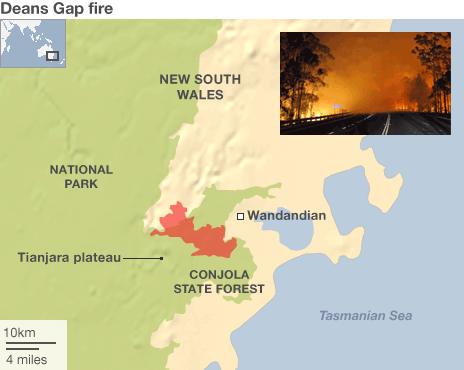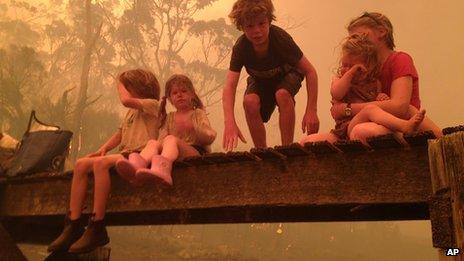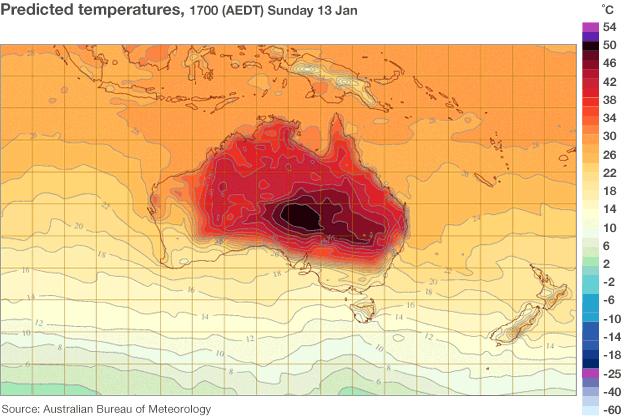Australia battles scores of bushfires
- Published
Footage shows the smoke plumes seen from space, as the BBC's Nick Bryant reports
Fire crews are tackling dozens of bushfires in south-east Australia, as forecasters predict another spell of hot weather for the weekend.
More than 100 separate fires are burning in New South Wales. Some 3,000 sq km of land has been razed.
One of the fires is encroaching on a disused army range littered with unexploded bombs, though fire crews are confident they can tackle the blaze.
Dozens of homes have been destroyed, but no-one is believed to have died.
Wildfires plague Australia most years during the hot, dry summers.
The worst fires in recent memory killed more than 170 people in early 2009.
This year, a spell of record-breaking hot weather across the south-east has helped fan the fires.
'Tornadoes of fire'
Tasmania was the first state to be affected, before fires broke out in New South Wales.
Some blazes have also been reported in Victoria and Queensland.
Officials said of some 120 fires in New South Wales, 17 remained uncontained, and more than 3,000 sq km (1,160 sq miles) of land has been destroyed.

The worst blazes are in the state's south near Yass, Sussex Inlet and Cooma.
At Dean's Gap, near Sussex Inlet, more than 100 firefighters are trying to stop the blaze reaching the disused army range.
They are using special gels and bulldozers to carve out containment lines.
"We need to get a really good handle on that fire before high fire danger conditions return," said a Rural Fire Service (RFS) spokeswoman.
Firefighters have been scrambling to take advantage of cooler weather on Wednesday and Thursday.
In Cooma, there are at least 80 firefighting aircraft, 360 fire trucks and more than 1,000 RFS volunteers trying to contain the fires in the area, local reports say.
Bushfires also continue to cause concern in Tasmania.
A large blaze is still burning out of control by the Tasman peninsula, near areas already hit by major blazes over the weekend.
More than 200 sq km of land and 120 homes have been destroyed.
"Even though conditions at the moment have calmed down a little bit, that doesn't mean that people can become complacent," said Tasmania Fire Service's Paul Symington.
"They still need to be vigilant, still monitor the websites and the radios because if things do change, they need to be on top of it."

A couple in Tasmania and their five grand-children, pictured here, sought shelter in the water under a jetty as flames closed in on the town of Dunalley
Photos of a Tasmanian family clinging to a jetty surrounded by fire have been widely shared by the international media.
Tim Holmes said he and his wife and their five grandchildren sought shelter in the water under a jetty for three hours.
"We saw tornadoes of fire just coming across towards us and the next thing we knew everything was on fire, everywhere all around us," he said.
Later on, he managed to make his way to shore and fetch a dinghy to transport his wife and the children.
Meanwhile firefighters in south-west Victoria continue to battle a bushfire near Portland. The state government said it was considering offering emergency grants to people who had lost their homes.

Temperatures have been so high the Australian Bureau of Meteorology has increased its temperature scale to 54 degrees, and added a new colour code.
The fires follow days of searing heat.
The national average maximum daily temperature exceeded 39C (102F) from 2-8 January, breaking a previous record of four consecutive days of such heat.
Average national top temperatures on Monday of 40.33C set a new record.
The bureau has added new colours to its forecast chart to indicate temperatures above the previous 50C limit because of the heatwave.
It said extreme temperatures would continue, external in Australia for the next week.
- Published9 January 2013
- Published9 January 2013